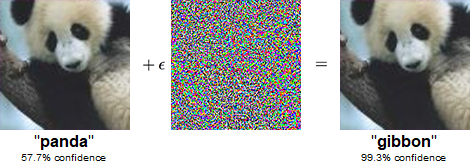Adversarial Attack
Contents
Adversarial Attack#
Synonyms: Adversarial Input, Adversarial Example.
In brief#
An adversarial input is any perturbation of the input features or observations of a system (sometimes imperceptible to both humans and the own system) that makes the system fail or take the system to a dangerous state. A prototypical case of an adversarial situation happens with machine learning models, when an external agent maliciously modify input data –often in imperceptible ways– to induce them into misclassification or incorrect prediction. For instance, by undetectably altering a few pixels on a picture, an adversarial attacker can mislead a model into generating an incorrect output (like identifying a panda as a gibbon or a ‘stop’ sign as a ‘speed limit’ sign) with an extremely high confidence. While a good amount of attention has been paid to the risks that adversarial attacks pose in deep learning applications like computer vision, these kinds of perturbations are also effective across a vast range of machine learning techniques and uses such as spam filtering and malware detection. A different but related type of adversarial attack is called Data Poisoning, but this involves a malicious compromise of data sources (used for training or testing) at the point of collection and pre-processing.
More in detail#
The vulnerabilities of AI systems to adversarial examples have serious consequences for AI safety. The existence of cases where subtle but targeted perturbations cause models to be misled into gross miscalculation and incorrect decisions have potentially serious safety implication for the adoption of critical systems like applications in autonomous transportation, medical imaging, and security and surveillance.
To get an idea of what adversarial examples look like, consider the example in Fig. 16 shown in [3]: starting with an image of a panda from ImageNet [4], the attacker adds a imperceptibly perturbation (i.e., an small vector whose elements are equal to the sign of the elements of the gradient of the cost function with respect to the input), to make the image be recognised as a gibbon with high confidence by a particular deep neural net (GoogLeNet [3]). Also, recent research has shown that even in physical world scenarios, machine learning systems are vulnerable to adversarial examples: [4] shows how printed adversarial images (with modifications imperceptible to the human eye) obtained from a cell-phone camera are not correctly classified by the models. In general, adversarial examples have the potential to be dangerous. For example, attackers could target autonomous vehicles by using stickers or paint to create an adversarial stop sign that the vehicle would interpret as a ‘yield’ or other sign, as discussed in [5].

Fig. 16 An adversarial input, overlaid on a typical image, can cause a classifier to miscategorise a panda as a gibbon. Adapted from [3].#
In response to concerns about the threats posed to a safe and trusted environment for AI technologies by adversarial attacks a field called adversarial machine learning has emerged over the past several years. Work in this area focuses on securing systems from disruptive perturbations at all points of vulnerability across the AI pipeline. One of the major safety strategies that has arisen from this research is an approach called model hardening, which has advanced techniques that combat adversarial attacks by strengthening the architectural components of the systems. Model hardening techniques may include adversarial training, where training data is methodically enlarged to include adversarial examples. Other model hardening methods involve architectural modification, regularisation, and data pre-processing manipulation. A second notable safety strategy is runtime detection, where the system is augmented with a discovery apparatus that can identify and trace in real-time the existence of adversarial examples. A valuable collection of resources to combat adversarial attack can be found at this link.
Bibliography#
- 1(1,2)
Ian J Goodfellow, Jonathon Shlens, and Christian Szegedy. Explaining and harnessing adversarial examples. arXiv preprint arXiv:1412.6572, 2014.
- 2
Olga Russakovsky, Jia Deng, Hao Su, Jonathan Krause, Sanjeev Satheesh, Sean Ma, Zhiheng Huang, Andrej Karpathy, Aditya Khosla, Michael Bernstein, and others. Imagenet large scale visual recognition challenge. International journal of computer vision, 115(3):211–252, 2015.
- 3
Christian Szegedy, Wei Liu, Yangqing Jia, Pierre Sermanet, Scott Reed, Dragomir Anguelov, Dumitru Erhan, Vincent Vanhoucke, and Andrew Rabinovich. Going deeper with convolutions. In Proceedings of the IEEE conference on computer vision and pattern recognition, 1–9. 2015.
- 4
Alexey Kurakin, Ian J Goodfellow, and Samy Bengio. Adversarial examples in the physical world. In Artificial intelligence safety and security, pages 99–112. Chapman and Hall/CRC, 2018.
- 5
Nicolas Papernot, Patrick McDaniel, Ian Goodfellow, Somesh Jha, Z Berkay Celik, and Ananthram Swami. Practical black-box attacks against machine learning. In Proceedings of the 2017 ACM on Asia conference on computer and communications security, 506–519. 2017.
This entry was readapted from Leslie David. Understanding artificial intelligence ethics and safety. The Alan Turing Institute, https://doi.org/10.5281/zenodo.3240529, 2019 by Jose Hernandez-Orallo, Fernando Martinez-Plumed, Santiago Escobar, and Pablo A. M. Casares.
